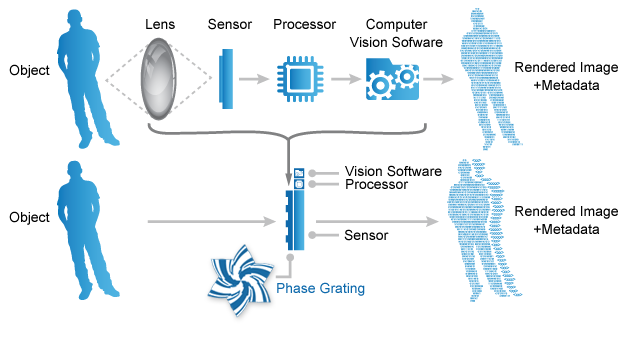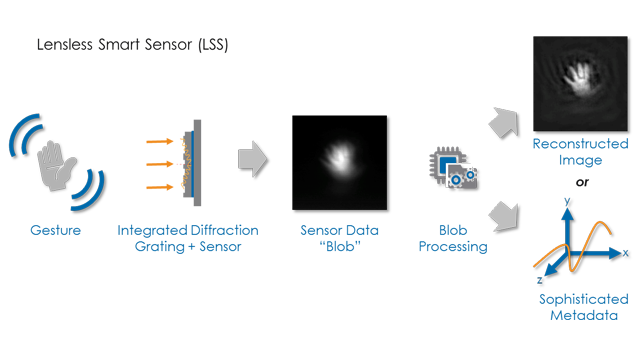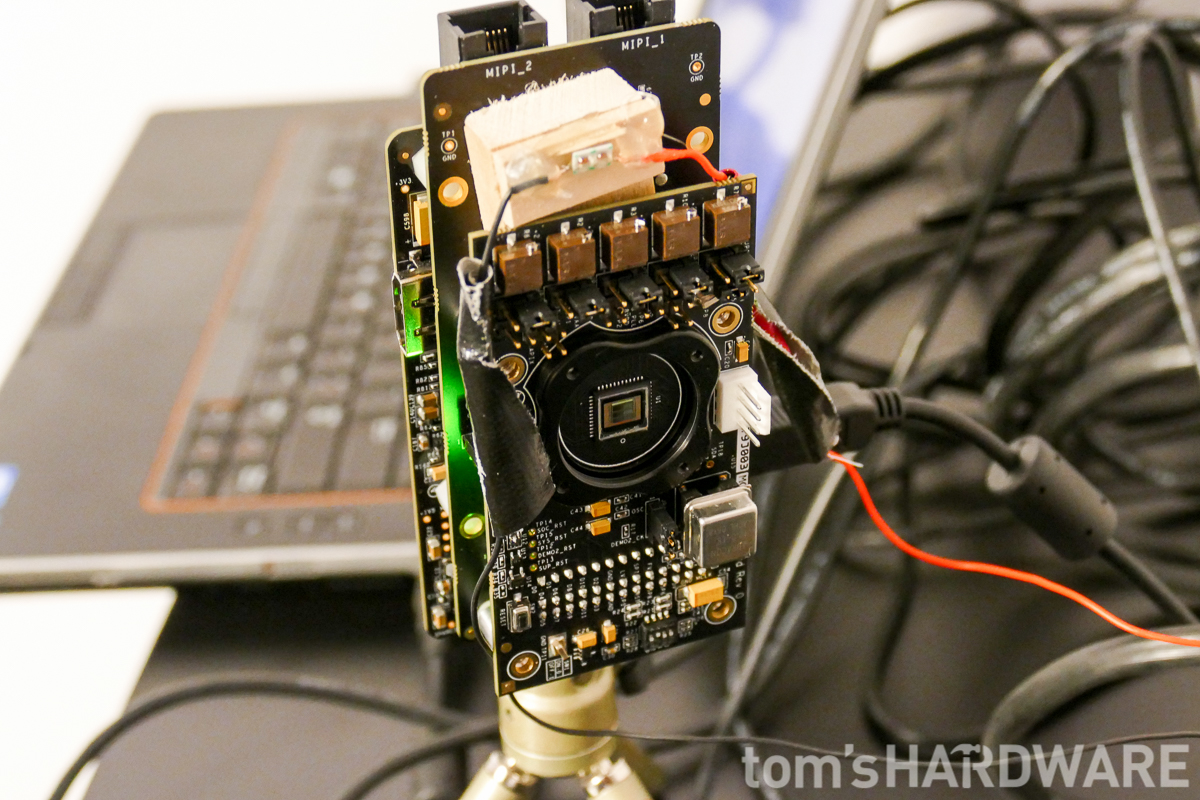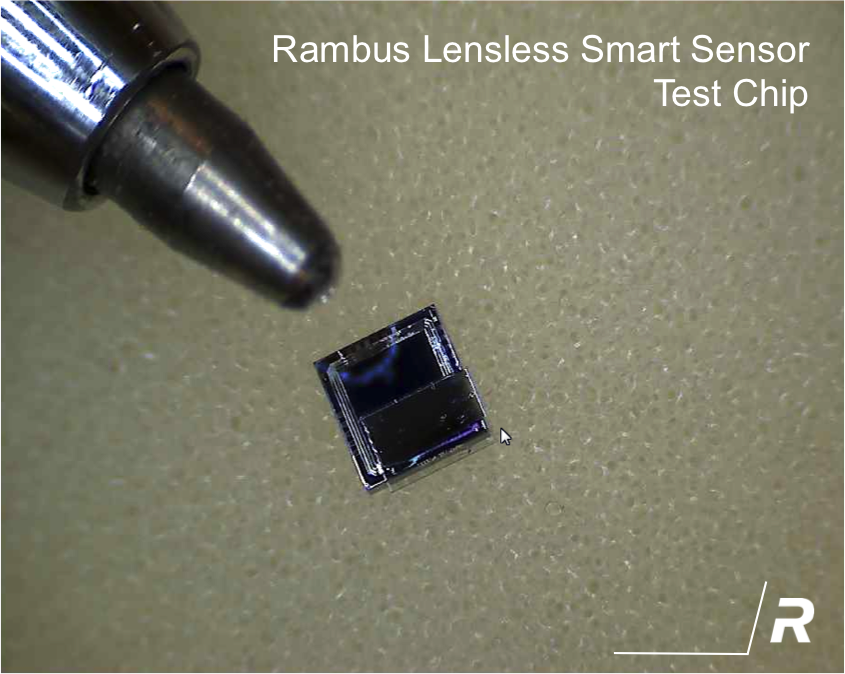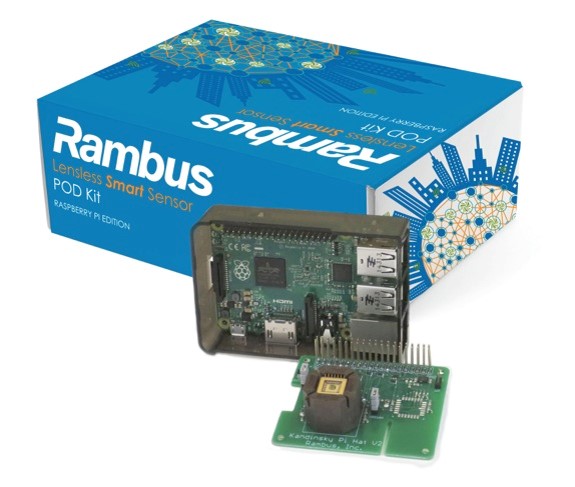Rambus Lensless Smart Sensor: A Tiny Image Sensor Designed For IoT
Remember Rambus? The company that developed RDRAM (Rambus DRAM). No? That's not surprising; we haven't heard much from them in the past decade since RDRAM stopped being Intel's standard for memory. Well, apparently the company has been quite busy over the years, with RDRAM and its successor XDR DRAM, currently being used in PlayStation 2 and 3.
We were surprised to see Rambus at Mobile World Congress promoting its new solid state Lensless Smart Sensor (LSS), a tiny, no bigger than a human hair, image sensor. It is designed for use in Internet of Things (IoT) devices like SmartCity sensors, automotive sensors and even wearables to capture image data, such as gestures, and also to accurately measure distances. The images above and below show how LSS captures and images data differently that traditional sensors.
When we met with Rambus reps, we were told that they had presented the concept of this technology at last year's CES with a prototype unit. At MWC 2015 they had a demo of the final LSS in action, which they were able to show us.
The video below from Rambus goes into more detail about the high-level idea behind this technology and its potential applications.
And this video, which we shot at MWC, is a detailed demonstration of the LSS that shows how it can be used to read gestures and measure distances. We also discuss some real-world use cases for the sensor.
Above is a shot of a development board with the LSS in the middle. While this setup, which is being used to show off the sensor's capabilities, is quite large, as mentioned before, the sensor itself is tiny. The picture below shows it in comparison to the tip of a ballpoint pen.
It is also incredibly power-efficient due to its small size and simplicity, so it can be used in devices that wouldn't normally have the resources available to them to power an image sensor for something like gesture recognition. I think that LSS will have applications in a lot of wearable technology too, from smartwatches to smartglasses, since power consumption and size are key for those products.
Get Tom's Hardware's best news and in-depth reviews, straight to your inbox.
The other important announcement Rambus made at MWC was their Partners-in-Open-Development (POD) program. The initial partners are product strategy and design firm, Frog, and product design and prototype firm, IXDS.
Partners in the POD program will be able to acquire a development kit (shown above) that includes either an Arduino, Raspberry PI or Intel Galileo board along with the LSS test chip, apps, firmware and SDK.
While on the surface the Rambus Lensless Smart Sensor isn't exactly a sexy product -- it's not the latest mobile SoC that is going to find its way into your latest smartphone -- it is an important product. Tiny sensors such as these are going to be used in always-on, always-connected smart devices that are going to improve every part of our daily lives in the near future. And Rambus' Lensless Smart Sensor will help create that future.
Follow Alex Davies @alexbdavies. Follow us @tomshardware, on Facebook and on Google+.
-
tburns1 But of course, any images the sensor takes of you will be considered their IP. Any subsequent pictures you take of yourself will be considered patent infringement and YOU WILL BE SUED! I wonder if they will try to patent light itself ...Reply -
derekullo Apple already sued light after it bounced off the original iPhone without paying royalties.Reply -
warezme How did Rambus go from a patent troll that produced nothing and earning cash from law suites to making something? Did they buy a company with all their ill gotten booty.Reply -
ethanolson Diffraction grating on this thing means that it has an aperture that's nasty for low-light. I'm talking like f/150. Whatever. Well... it's cool to see innovation. I hope they learned form the past and will let the innovation thrive instead of stupid lawsuit crap.Reply -
bit_user Reply15424530 said:How did Rambus go from a patent troll that produced nothing and earning cash from law suites to making something?
Why do you assume they're no longer interested in monetizing IP in any way possible? They milked the memory industry for a long time and seem to have decided to branch out into other fertile markets. They actually have their fingers in a lot of pies, like LED lighting.15425762 said:Whatever. Well... it's cool to see innovation. I hope they learned form the past and will let the innovation thrive instead of stupid lawsuit crap.
I think they probably fall somewhere in between an IP factory, like Intellectual Ventures, and a traditional semiconductor company. Take their LED lighting products, for instance. They don't do the manufacturing - just produce the designs. They then license those designs to other manufacturers who want to make them. And I'm sure they're busily suing companies they feel infringe on those designs, as well.
I'll be interested in seeing whether they continue to develop further lensless sensors, or whether this product satisfies their need to extract "value" from that market.
That said, I'm impressed with what they've done, here. Their LED lights seem pretty nice, too.
-
Solandri Reply
The principle behind this is nearly two hundred years old. In fact if you learned about Fourier transforms in school, you were probably taught this as an example. When light coming in from a window hits a wall, the light pattern on the wall is basically the Fourier transform of the image visible through the window. If you could take that light pattern on the wall and apply another Fourier transform (FTs are reversible this way), you'd get back the original image (i.e. the scene outside the window). Presto - a lensless camera.15424530 said:How did Rambus go from a patent troll that produced nothing and earning cash from law suites to making something? Did they buy a company with all their ill gotten booty.
The tricky part is, in order to take the Fourier transform of the light hitting the wall, the intensity (brightness) is not enough. You also need the phase of the light when it hits the wall. Capture that phase information, and you've basically got a lens-less camera. Everyone has been trying to figure out a way to do just that. Lytro's light field camera more or less does it by capturing light re-focused by microlenses in extremely high resolution after the focal plane, then using that data to compute the intensity and phase of light as it was crossing the focal plane. That's how you can refocus the image after the "photo" is taken - you just recompute it with the focal plane at a different location.
As computing power advances, people are probably going to come up with dozens if not hundreds of different ways to do this. So it's highly unlikely that Rambus' way will be THE way it's done in the future. The bigger risk is they'll get an overreaching patent which gives them control of a huge area of research that they haven't done and thus have no legitimate right to.
I'm not even sure this is the direction photography is going to go anymore. 10 years ago I would've said definitely. But the intervening decade has seen regular cameras and sensors shrink so much, now you can just put two or more cameras on a phone, have them take photos simultaneously, and have a computer use parallax in the pictures to pull out depth information and recreate the original scene in 3D. -
synphul Just what society was missing, more cameras. Seriously, it states the usage goal geared to IoT. Why exactly does my new age fridge need a photo of me? To send it to the toaster when my back is turned and snicker over my expanding waistline? I dunno about everyone else, but I'm getting sick of camera/mic infused devices spying on me every time I turn around. I'm all for tech but not at the expense of privacy.Reply -
OrumusST On a technological point of view I find the forward momentum created by the drive towards the IoT great. However the easier and cheaper it is to embed senors of every kind into everyday innocuous objects means we are also moving towards a future where privacy does not exist.Reply
I am uncertain if we as a society will be able to use this power without stamping out individual freedoms. As of right now I know we can not as is proved with every leak about governments spying on citizens and companies trying to monetize everything.
The IoT could be an extremely helpful tool or a tool for control and oppression. -
falchard Something tells me that chip is actually just a copper model that does not do anything, and they copyrighted the idea of creating a lens-less sensor. So from now on everyone has to uses a lens in sensors or pay Rambus money.Reply

